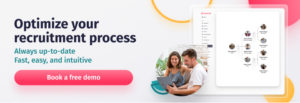As employers, we are facing an important crossroads as a result of a rapidly evolving talent market. We are seeing rising levels of resignations, changing employee expectations, and a widening talent gap. In order to stay ahead of the game and attract the right talent, we need to adapt our hiring strategies and the way we manage our workforce. And this requires having access to the right data so that we can make informed data-driven decisions at every stage of the hiring practice. In other words, we need to measure the right talent and recruitment analytics in order to effectively navigate this changing landscape and stay competitive as an employer.
In today’s post, we are going to explain what recruiting analytics is, which Recruitment KPIs you should be tracking, and why recruitment data analysis has become such a key element of the hiring process.
What is Recruitment Analytics?
Recruitment analytics is a form of people analytics that you use to track, manage and analyze all the metrics relating to your hiring process. This includes your sourcing, selection, and hiring processes, as well as the overall impact of new hires on your retention and turnover levels. The aim is to identify bottlenecks and areas for improvement so that you can streamline your entire process and offer a better candidate experience. For example, if a high rate of new hires leaves your business within the first three months, it could suggest that you have an issue somewhere in your hiring cycle. This might be down to selecting the wrong candidates or not offering an effective onboarding experience to new recruits.
Before you can analyze your metrics, you need to collect as much information as possible about your recruitment funnel and the impact it has on your business. There are a number of sources you can use for this. For example, you can gather insights on your selection and recruitment processes through an Applicant Tracking System. You can use performance management software to determine a new hire’s ramp-up time to see how quickly they are becoming productive members of staff. And you can use employee satisfaction surveys to find out how effective your recruitment and onboarding processes are. Then, once you’ve collected all your data, you can begin to analyze it in order to work out your strategies for improvement, as we will see shortly.
Why is recruitment analytics important?
Recruitment analytics are becoming increasingly valuable in HR departments these days. In fact, according to a recent report by Deloitte, 71% of companies see talent analytics as a top priority in their organizations. This is partly due to the increasing availability of big data. However, it is also gaining weight due to changes in the job market and the overall increase in turnover that many companies are experiencing as a result of the Great Resignation. Companies are realizing that, in order to compete in a saturated market and attract top talent to their business, they need to focus on workforce analytics and implement more data-driven recruitment strategies.
For instance, recruiting analytics can help you answer questions like:
- What is your average cost per hire?
- How long is your average time to hire?
- Are you offering a positive candidate experience?
- What is your revenue per hire?
- Is your offer acceptance rate acceptable?
- Is your quality of hire in line with expectations?
The insights you collect from regularly monitoring your recruitment analytics can also extend beyond your HR department. This is because the more efficiently your hiring processes run, the better-quality talent you will attract and the more likely new recruits will become loyal and productive members of your team. And this helps you reach your company objectives and improve your business operations, which has a direct impact on the bottom line of your organization.
Benefits of recruitment analytics
Recruitment analytics can benefit your business in a number of ways.
Some of the biggest advantages are that they:
- Help you create a more efficient selection and recruitment process
- Improve your quality of hire
- Optimize your hiring costs
- Provide you with valuable insights so that you can monitor the performance of new hires
- Enable you to create processes focused on promoting diversity and inclusive hiring practices
- Ensure you have all the data you need in order to effectively predict your future hiring needs and budget accordingly.
Let’s look at some of these benefits of tracking recruiting analytics in a bit more detail.
Improve your quality of hire
Recruitment analytics can help you identify top candidates, make better hiring decisions and improve your quality of hire. This is because you better understand what you should be looking for when you fill open positions, and you are able to make the necessary changes so that your hiring processes run more smoothly. You also save a lot of time as you don’t need to screen hundreds of potential candidates in order to find the right fit. Plus, the better suited a candidate is to a position, the less likely they are to leave your business, helping you to reduce turnover and associated labor costs.
Diversify your workforce
With the data you collect for your analytics and hiring reports, you are able to evaluate the demographics of both your existing workforce and the candidates that apply for positions at your company. You can then use this data to create diversity metrics to help you understand if your DEI initiatives are effective and if your hiring funnel is diverse and inclusive. And the more diverse you are as a company, the better your reputation as an employer will become.
Boost efficiency
Recruitment analytics help you answer important questions about your hiring process. For example, you can identify if your processes are running smoothly or if there are any bottlenecks that are slowing down the hiring cycle. Armed with this data, you can make the necessary changes to ensure that each stage of your recruitment funnel is running as efficiently as possible. And this saves you valuable time and money.
It also helps you avoid potential understaffing issues so that your organization runs as productively as possible. Plus, the more smoothly your hiring process is, the better experience candidates and new hires have with you. And this helps to improve your brand and reputation as an employer.
Predict future hiring needs
Having access to historical data about your recruitment process can help you identify trends and patterns which, in turn, make it easier for you to predict future hiring needs. This makes it easier to plan ahead so that you can address potential talent and skill gaps in advance. Recruitment forecasting also enables you to estimate potential hiring costs and calculate your budgets accordingly.
Key metrics in recruitment analytics
There are a number of HR KPIs that you should be tracking as part of your overall recruiting analytics strategy. Each metric serves a different purpose, so the indicators you focus on will depend on your specific goals and expectations.
Generally speaking, though, these are the most useful recruitment KPIs that you should be regularly monitoring and evaluating.
Time to hire
This is used to measure how long it takes you to hire a new recruit from the point of publishing a job vacancy. In other words, the average number of days it takes you to fill a position, from start to finish.
This metric is important because the longer it takes you to hire a candidate, the higher the chance that they will be offered another position from one of your competitors. If your time to hire is too long, then it suggests there might be a bottleneck somewhere in your hiring process that is causing delays.
Cost per hire
Of all the recruitment KPIs, this one is the most closely related to what you need to invest in sourcing, interviewing, hiring and onboarding a new employee. It’s a measure of the resources you dedicate to your recruitment process so that you can determine if you are spending too much (or too little) at any of the stages of your funnel. Recruitment labor costs include advertising positions, the time spent reviewing and selecting potential candidates, interviews and onboarding and any associated administrative costs.
You can calculate this by dividing your overall hiring costs by the number of new recruits you take on during a given period.
Revenue per hire
This metric is used to calculate your revenue per employee so that you can work out how much revenue each new hire is generating for your business. That way you know whether they are making a positive impact and if you are getting a return on your hiring investment.
To calculate revenue per employee, simply measure the total revenue that your company generates over a given period, then divide this figure by your current number of employees.
Offer acceptance rate
It’s also important to calculate how many of your job offers are being accepted. This is important because if high levels of candidates are rejecting your offers, then it suggests there is an issue in the final stages of your hiring process. This might be down to your compensation and benefits program. It could also suggest there is an issue with your candidate experience. By determining what the issue is you can raise your offer acceptance rate and reduce your hiring costs.
Candidate experience
We’ve already mentioned the candidate experience a few times here. That’s because the experience you offer potential new employees is vital. First impressions matter. If a candidate has a bad experience, then they will be unlikely to want to join your organization.
The best way to collect this data is through feedback. You can distribute candidate surveys to find out what new hires dislike about your hiring process. You can also collect valuable feedback from sites like Glassdoor.
Quality of hire
Finally, and perhaps most importantly, it’s important to track and evaluate the quality of candidates that are joining your company. Essentially, this is whether or not new hires are meeting your expectations.
How long does it take them to become productive members of staff? Are they performing as expected? Do they have the skills and experience needed to fulfil their duties? How long are they staying at your company once you’ve hired, onboarded and trained them?
If your quality of hire is low, then you need to identify what is going wrong in your selection and interview process. This might be as simple as creating more informative job descriptions. Or you could use interview scorecards to make sure you’re asking candidates the right questions.
Levels of recruitment analytics
When you look at your recruitment analytics, it’s important to divide them into three clear levels. These levels are operational reporting, advanced reporting, and predictive analytics.
Let’s take a look at these recruiting analytics levels in a bit more detail.
Operational reporting
The first level of recruitment analytics is operational reporting. This level relates to your key hiring metrics. This includes your cost of hiring, applicants per open position, time to fill, and time to hire. You can then use this data to make adjustments to your selection and recruitment funnel where necessary.
These reports can also help you determine if your recruitment staff are effectively managing your hiring process. If not, you need to make adjustments to the team. For example, you could offer more training or take on more HR staff.
The best way to collect data for these analytics is through an Applicant Tracking System (ATS). ATS systems like Factorial HR serve as an end-to-end recruitment solution. In other words, they cover every stage of the hiring process, from start to finish.
What’s more, with Factorial’s ATS you can easily create your own customized hiring page, showcasing your company and available positions. And once you’ve hired a candidate, you can seamlessly integrate them into your HRIS system. This will help the process of passing from candidate to employee run as smoothly as possible.
Advanced reporting
Advanced reporting takes things a step further. It enables you to take a deeper look at how your processes are running. KPIs usually include cost per candidate, an analysis of recruitment sources, employer branding, and recruitment funnel conversions.
With this second level of reporting, you will need to collect data from a variety of sources. For example, you might decide to analyze the candidate experience through surveys and questionnaires. You could also use journey mapping to create a visual representation of the candidate experience. This will help you identify what you need to improve. It’s also a good idea to use tools to measure your employer brand and reputation to see whether you are doing all the right things to attract top talent to your business.
Predictive analytics
The third level of recruitment analytics relates to predictive reporting. This level is all about statistical analysis, segmentation, and creating candidate personas. All this helps you create hiring models that enable you to predict future hiring needs and plan accordingly.
For example, you could start by identifying your candidate and employee segments. Once you’ve done that, create a persona for each segment. Make sure you consider all the interactions each persona has with your organization.
Are there any processes that might frustrate candidates? Are there any barriers preventing them from having a positive journey in your company? What about any specific areas of your recruitment funnel where candidates drop out of the hiring process?
All this will help you optimize your hiring costs and increase your candidate conversions.
Recruitment analytics best practices
Let’s finish by taking a look at a few recruitment analytics best practices. These will help you get the most from your recruitment analytics.
- Make sure you are tracking the right HR KPIs for the specific needs of your business. The right metrics will depend on your company’s objectives. Here’s a handy free KPI template to get you started.
- Collect relevant data. There’s no point in tracking your hiring metrics unless you are collecting all the right data. This will help you make informed decisions about your processes. For example, if you want to improve your candidate experience then make sure you are sending our regular candidate surveys.
- Visualize your data. Make sure your recruitment software includes an intuitive hiring dashboard so that you have easy access to all the data you need. This makes it much easier to identify trends and spot areas for improvement. Check out this hiring dashboard template for more information.
- Use the right HR analytics software. With Factorial’s all-in-one analytics solution you get easy access to all the data sources you need to track the right metrics for your HR reports. You also get access to an intuitive HR dashboard so that you can create a customized space to manage all your recruitment analytics.
- Finally, make sure you use recruitment analytics to improve your overall hiring process. After all, the ultimate goal of tracking all the valuable data you collect with your HR reports is to streamline your recruitment funnel so that it runs more efficiently. Make sure it counts.




